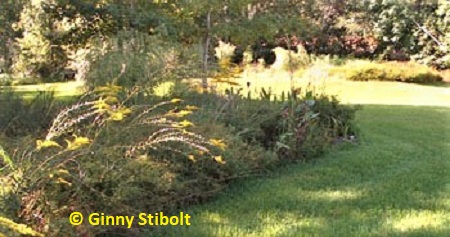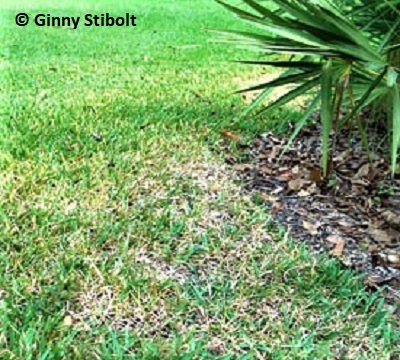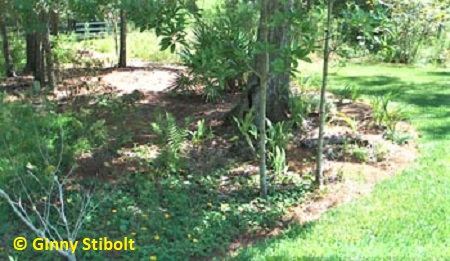Adventures of a Transplanted Gardener |
||||||
Reducing the lawn in your landscape
|
||||||
 |
Several areas out back are now meadows... |
Creating wild areas
We stopped mowing sections where the grass was not doing well on our 1.5-acre lot. We've de-lawned under trees, at the edge of the pond out front, along the edge of the woods on the way down to the lake, and on top of that large mound out back. (While it may look like a elephant burial ground, it's our septic drain field.) The open, sunnier areas are now entrancing small meadows, alive with wildlife. The areas directly under trees are mulched with leaves and pine needles, and I'm in the process of planting shrubs here to create more interest. I've created mulched paths that meander through our new wild areas.
I'm sure my neighbors think I'm crazy, because I scrape the pine needles from the street gutters and storm drains. But this way, I have a never-ending supply of free mulch and our lake doesn't have to absorb all that extra organic material. I never, ever bag fall leaves for the landfill or (gasp!) burn them to pollute the air. I always use Mother Nature's fall gifts to improve the soil. More on composting in my next column. (Update: Years later I wrote, 6 reasons to use pine needle mulch in edible gardens.)
Moving through the seasons for last 18 months has produced a fascinating display as a wide array of plants, insects, and animals have made their appearances. The meadow areas in particular have provided a wonderful show. The plants have included Ladies Tresses (Spiranthes praecox), Lawn Orchids (Zeuxine strateumatica), Meadow Beauty (Rhexia mariana), Blue Curls (Trichostema dichotomum), Beggars Ticks (Bidens alba), Goldenrod (Solidago odora), Dog Fennel (Eupatorium capillifolium), and many more.
We are fortunate to have wooded lots and trees around our house, so seeds in the ground are abundant—it's our seed bank. Plus rhizomes, runners, and other invading plant parts were just waiting for the mowing to stop. If you live in a newer development where the soil may be more sterile or where the grass is thicker, just letting the grass grow may not produce the diversity that we experienced.
 |
We will incorporate this poor lawn area into the adjacent mulched bed. |
Start with a plan
Start with a plan for removing lawn from edges of your lot, under trees, in wet or low spots, along slopes, and in ditches. Look for areas where the grass is not doing well and merge these areas with adjacent beds or meadows. For example, this photo shows some poor grass growth. The next time I go around this area with my low-tech edger, AKA my shovel, I'll dig it up and mulch it. In this shaded area, I'll probably plant some ferns next to the >saw palmetto (Serenoa repens).
Plan for pathways, benches, and water features that people will use and enjoy while viewing the diversity you'll have created. Then plan for dense shrubbery areas for wildlife cover, for privacy screening, and for sound barriers. It won't happen all at once and rearranging is allowed. The path I established in the front meadow had to be rerouted, because the original location retains water for a long time after a hard rain. This is a little-at-a-time type of project, especially if you remove the grass with a shovel.
Fall is the perfect time for layered gardening
Layered gardening uses layers of organic material to cover and kill existing vegetation. In this case, the layers of leaves, wood chips, or other organic materials. This allows you to de-lawn a larger area with less strain on your back, less invasion of the soil; and the dead plants under the layers creates another layer of mulch. This is not the same as using a weed barrier in areas where you don't want plants to grow.
For the mulched areas under trees and around shrubs, mark out the area—remembering to add some gentle curves to the border for interest, flatten the weeds, and cover the area with cardboard or at least eight layers of newspaper. Dampen the paper, cover it with leaves and/or mulch, and dampen again. This will kill most plants under the layers in a couple of weeks. If you are planting shrubs or trees in your new, wild area at this time, you will need to remove all the grass and weeds at each planting site. Surround your new plantings with this layered mulch.
For the meadows, if you wish to give your wildflowers a better chance, you may also use the layered approach to kill the grass and weeds. You may want to add a layer of topsoil and tamp it all down. There are a number of wildflowers that are sown in the fall and another group that are sown in the spring. Go for a native mix that will provide flowers through the seasons for you to enjoy, and will provide continuous sources of pollen or nectar for the insects and hummingbirds. Pay attention to the plants' need for sun or shade for this project.
For our meadows, we did not kill the existing plants: we just stopped mowing. This is a riskier method because we had no idea what we'd end up with, but then, we don't have neighborhood regulations to deal with. It's been an interesting adventure.
Resources for further information:
- This site is a mouthpiece for lawn service companies, but its lawn
and lawnmower histories are widely quoted:
www.american-lawns.com/history/history_lawn.html.
- Beyond Pesticides provides lots more information on this topic:
www.beyondpesticides.org.
Ginny Stibolt is a life-long gardener, a botanist, a naturalist, and a garden writer. You may contact her or read more of her articles posted on her website: www.greengardeningmatters.com.
Copyright Ginny Stibolt


